Archive:Asylum quarterly report
- Data from March 2014. Most recent data: Further Eurostat information, Main tables and Database.
Asylum applicants and first instance decisions on asylum applications: first quarter 2014
Nearly 25 000 more asylum applicants in the EU-28 during the first quarter of 2014, compared with the first quarter of 2013
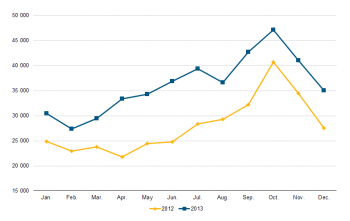
This article describes recent developments in relation to numbers of asylum applicants and first instance decisions on asylum applications in the European Union (EU). Asylum is a form of international protection given by a state on its territory. It is granted to a person who is unable to seek protection in his/her country of citizenship and/or residence, in particular for fear of being persecuted for reasons of race, religion, nationality, membership of a particular social group, or political opinion.
Main statistical findings
Increase in asylum applicants
The number of asylum applicants increased by 29 % in the first quarter of 2014 compared with the same quarter of the previous year. Overall, the number of persons seeking international protection in the EU-28 in the first quarter of 2014 reached 108 300. This was 24 320 more than in the same quarter of 2013 (Table 1).
Where do they come from?
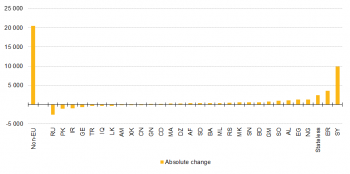
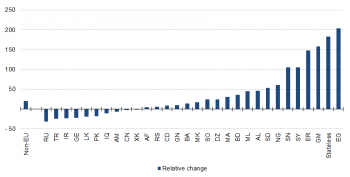
Citizens of 148 countries together with stateless persons sought asylum in the EU in the first quarter of 2014. The main 3 citizenships were Syrians, Afghanis and Serbians, lodging 16 770, 7 895 and 5 960 asylum applications respectively (Table 2).
Syrians added most to the overall increase in asylum applicants in absolute terms, followed by Serbians, Afghanis and Albanians (8 505, 2 595, 2 515 and 2 135 more applicants respectively) (Figure 2, Table 2).
Compared to 2013, Gambian, Senegalese and Bangladeshi asylum applicants recorded by far the largest relative increases during the first quarter of 2014. Egyptians quadrupled and Senegalese and Bangladeshi almost tripled, recording 2 015, 1 350 and 2 455 asylum applications respectively (Figure 3, Table 2).
Main destination countries
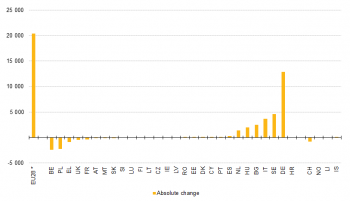
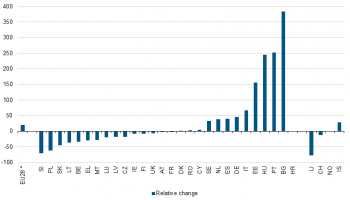
In the first quarter of 2014 the largest numbers of applications for international protection were lodged in Germany, France, Sweden and Italy (36 890, 15 885, 12 945 and 10 700 respectively), representing more than 70 per cent of all applications in the EU-28.
Countries that previously were receiving few numbers of asylum applicants are now seeing huge increases in asylum seekers. Such a country is Bulgaria (2 030) where the number of asylum applicants has more than doubled, compared with the first quarter 2013.
The country with the highest number of applicants relative to its population in first quarter 2014 was Sweden, with more than 1 300 applicants per million inhabitants, followed by Switzerland and Luxembourg (605 and 500 respectively) (Table 1).
Of the 15 EU Member States that recorded increases in asylum applicants, Germany and Italy recorded the highest increases in absolute terms (15 220 and 6 030 more respectively) (Figure 2, Table 1). In contrast, Poland and Belgium recorded the largest decreases in absolute terms (1 290 and 810 fewer applicants each). In relative terms, Latvia, Italy and Bulgaria were the countries having the largest percentage increases with respect to the same quarter of the previous year (170 %, 129 % and 126 % more applicants each) (Figure 2 and Table 1).
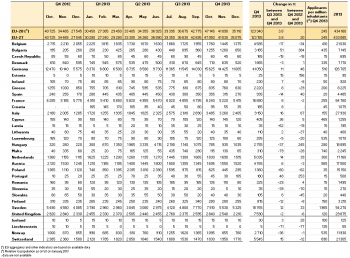
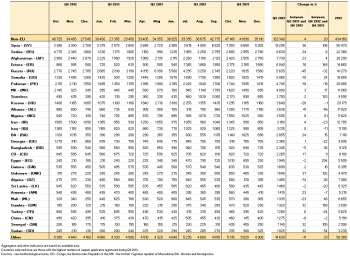

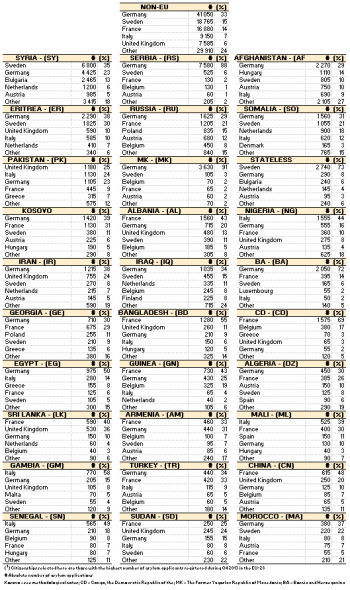
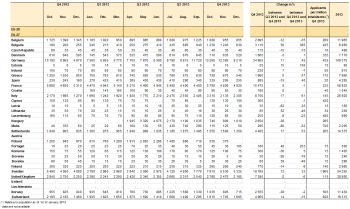
What is their age and sex?
Almost 8 in 10 of the 108 300 asylum applicants in the EU-28 were below the age of 35 and 1 out of 4 was a minor[1]. Notably, persons from Eastern European and Balkan countries, like Russians, Serbians, Bosnians and persons from FYROM, were those with the highest proportion of minor asylum seekers in the EU-28 in Q1 2014, more than 40 % (Table 7).
Female applicants represented 31 % of all asylum applicants in the EU. For Gambian and Senegalese and Malian citizens in particular, this proportion is even lower (ranging from 4 to 6 %). In contrast, for citizens of China, Congo, Russia and Armenia, the ratio of women to men was 1 to 1 (Figure 6, Figure 7).
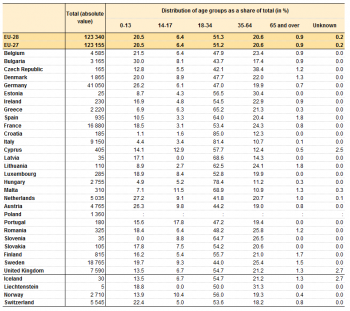
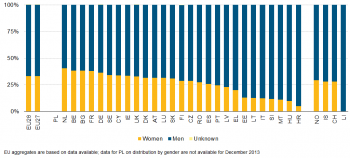
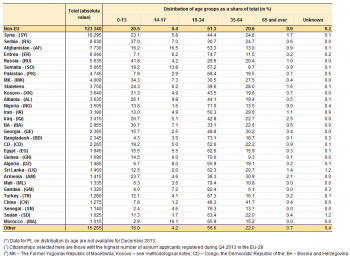
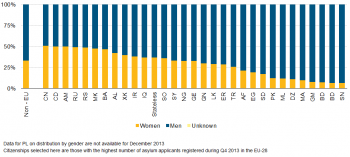
Decisions on asylum applications
81 280 first instance decisions were made by the national authorities of EU Member States during the first quarter of 2014. Amongst them, almost 40 % were positive granting a type of protection status.
While Germany, France and Sweden issued the most first instance decisions[2] during the first quarter of 2014 (21 235, 16 685 and 10 010 respectively), the rate of recognition[3] of asylum applicants varies significantly across countries. The countries with the highest rates of recognition of asylum applicants (without including recognition under national law, i.e. Humanitarian status) were Bulgaria (98 %), Sweden (77 %), Cyprus (67 %) and Malta (64 %), while those with the lowest were Greece (8 %), Portugal, Croatia and Estonia (9 % each).
In terms of citizenship, most decisions were issued to Syrians (14 685), Serbians (5 070), Afghans (4 045) and Pakistanis (3 930). The citizenships granted the most positive decisions (i.e. a type of international protection) were Syrians (14 260), Afghans, stateless persons, Eritreans and Somalis (more than 2 000 each) (Figure 9, Table 11).
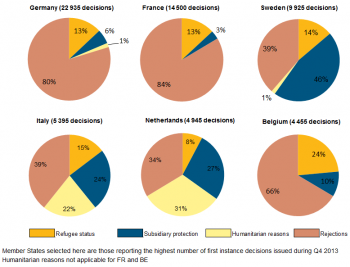
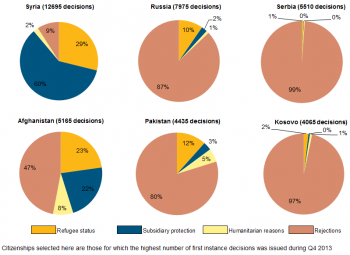

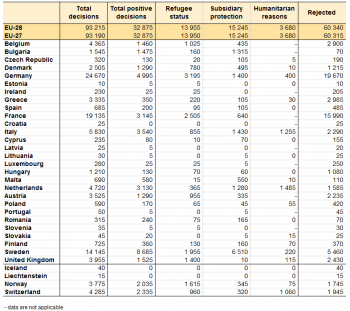
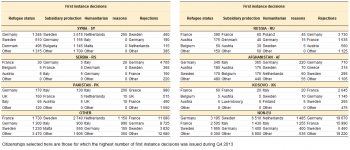

Data sources and availability
The data used for this publication are provided to Eurostat by the Ministries of Interior, Justice or immigration agencies of the Member States. Data are based entirely on relevant administrative sources. Apart from statistics on first asylum applicants, these data are supplied by Member States according to the provisions of Article 4 of the Regulation (EC) 862/2007 of 11 July 2007 on Community statistics on migration and international protection. All data presented in this publication are rounded to the nearest 5. All data presented in this article are provisional (except as otherwise stated) and may be a subject to change.
Context
The Directorate-General for Home Affairs (DG HOME) is responsible for developing EU policies on asylum.
The 1951 Geneva Convention relating to the status of refugees (as amended by the 1967 New York Protocol) has, for over 60 years, defined who is a refugee, and laid down a common approach towards refugees that has been one of the cornerstones for the development of a common asylum system within the EU.
Since 1999, the EU has worked towards creating a common European asylum regime in accordance with the Geneva Convention and other applicable international instruments. A number of directives in this area have been developed. The four main legal instruments on asylum — all recently recast — are:
- the Qualification Directive 2011/95/EU on standards for the qualification of non-EU nationals and stateless persons as beneficiaries of international protection, for a uniform status for refugees or for persons eligible for subsidiary protection;
- the Asylum Procedures Directive 2013/32/EU on common procedures for granting and withdrawing international protection;
- the Reception Conditions Directive 2013/33/EU laying down standards for the reception of applicants for international protection;
- the Dublin Regulation (EU) 604/2013 establishing the criteria and mechanisms for determining the Member State responsible for examining an application for international protection lodged in one of the Member States by a third-country national or stateless person.
The Hague programme was adopted by heads of state and government on 5 November 2004. It puts forward the idea of a common European asylum system (CEAS), in particular, it raises the challenge to establish common procedures and uniform status for those granted asylum or subsidiary protection. The European Commission adopted on 17 February 2006 a Communication on ‘strengthened practical cooperation’ (COM(2006) 67 final), presenting a vision of how EU Member States could further cooperate on asylum. The European Commission’s policy plan on asylum (COM(2008) 360 final) was presented in June 2008 which included three pillars to underpin the development of the CEAS:
- bringing more harmonisation to standards of protection by further aligning the EU Member States’ asylum legislation;
- effective and well-supported practical cooperation;
- increased solidarity and sense of responsibility among EU Member States, and between the EU and non-member countries.
With this in mind, in 2009 the European Commission made a proposal to establish a European Asylum Support Office (EASO). This proposal was formally approved during the first half of 2010 when a decision was taken by the Council and the European Parliament to locate the headquarters of this new office in Valletta, Malta. The EASO supports EU Member States in their efforts to implement a more consistent and fair asylum policy, for example, by helping to identify good practices, organising training at the European level, and improving access to accurate information on countries of origin. It also provides technical and operational support to EU Member States facing particular pressures (in other words, those EU Member States receiving large numbers of asylum applicants). The EASO became fully operational in June 2011 and has worked to increase its capacity, activity and influence, working with the European Commission and the United Nations high commission for refugees (UNHCR). The EASO has started to provide assistance to several EU Member States that formally requested support, including relocation of international protection beneficiaries within the EU’s pilot project on intra-EU relocation (EUREMA) from Malta, co-funded under the European refugee fund (ERF).
In May 2010, the European Commission presented an action plan for unaccompanied minors (COM(2010) 213 final), who are regarded as the most exposed and vulnerable victims of migration. This plan aims to set-up a coordinated approach and commits all EU Member States to grant high standards of reception, protection and integration for unaccompanied minors. As a complement to this action plan, the European migration network has produced a comprehensive EU study on reception policies, as well as return and integration arrangements for unaccompanied minors.
In December 2011, the European Commission adopted a Communication on ‘Enhanced intra-EU solidarity in the field of asylum’ (COM(2011) 835 final). This provided proposals to reinforce practical, technical and financial cooperation, moving towards a better allocation of responsibilities and improved governance of the asylum system in the EU, namely through:
- introducing an evaluation and early warning mechanism to detect and address emerging problems;
- making the supporting role of the EASO more effective;
- increasing the amount of funds available and making these more flexible, taking into account significant fluctuations in the number of asylum seekers;
- developing and encouraging the relocation of beneficiaries of international protection between different EU Member States.
Further Eurostat information
Publications
- Asylum applicants and first instance decisions on asylum applications: fourth quarter 2011 Statistics in focus 11/2012
- Number of Asylum applicants on rise during the first quarter of 2011 Statistics in focus 48/2011
Main tables
- Population, see:
- Population (t_populat)
- International Migration and Asylum (t_migr)
- Asylum (t_migr_asy)
- Asylum and new asylum applicants - monthly data (tps00189)
- Persons subject of asylum applications pending at the end of the month - monthly data (tps00190)
- Asylum and new asylum applicants - annual aggregated data (tps00191)
- First instance decisions on applications by type of decision - annual aggregated data (tps00192)
- Final decisions on applications - annual data (tps00193)
- Asylum applicants considered to be unaccompanied minors - annual data (tps00194)
- Resettled persons - annual data (tps00195)
- Asylum (t_migr_asy)
- International Migration and Asylum (t_migr)
Database
- Population, see:
- Population (populat)
- International Migration and Asylum (migr)
- Asylum (migr_asy)
- International Migration and Asylum (migr)
Dedicated section
Other information
- Regulation 862/2007 of 11 July 2007 on Community statistics on migration and international protection
- Directive 2013/33/EU of 26 June 2013 laying down standards for the reception of applicants for international protection (recast)
- Directive 2011/95/EU of 13 December 2011 on standards for the qualification of third-country nationals or stateless persons as beneficiaries of international protection, for a uniform status for refugees or for persons eligible for subsidiary protection, and for the content of the protection granted (recast)
- Directive 2013/32/EU of 26 June 2013 on common procedures for granting and withdrawing international protection (recast)
- Regulation (EU) No 604/2013 of 26 June 2013 establishing the criteria and mechanisms for determining the Member State responsible for examining an application for international protection lodged in one of the Member States by a third-country national or a stateless person (recast)
- Regulation (EU) No 603/2013 of 26 June 2013 on the establishment of 'Eurodac' for the comparison of fingerprints for the effective application of Regulation (EU) No 604/2013 establishing the criteria and mechanisms for determining the Member State responsible for examining an application for international protection lodged in one of the Member States by a third-country national or a stateless person and on requests for the comparison with Eurodac data by Member States' law enforcement authorities and Europol for law enforcement purposes, and amending Regulation (EU) No 1077/2011 establishing a European Agency for the operational management of large-scale IT systems in the area of freedom, security and justice (recast)
External links
- European Commission - Home Affairs - Asylum
- European Asylum Support Office - EASO
- European Migration Network - EMN
- UNHCR - Statistics